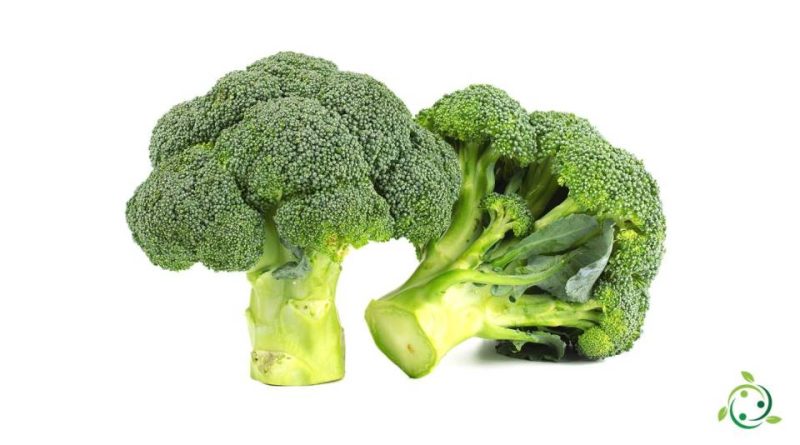Nutritional value of Broccoli
Nutritional value of Broccoli
Broccoli or broccoli cabbage (Brassica oleracea var. Italica), is a variety of the Brassica oleracea species, belonging to the Brassicaceae family.
Broccoli belongs to the group of plants whose leaves are not eaten but the inflorescences not yet ripe.
Features –
Broccoli is a plant that, if allowed to develop, grows up to 1.5 meters in height, forming abundant branches with flowering twigs. The flowers are yellow and, after fertilization, usually crossed and entomophilous, give rise to the formation of a siliqua carrying numerous round seeds, of a bluish black color. The salient difference between cauliflower and cabbage-broccoli is in the inflorescence, white and compact in the first, green and more indented in the second. The broccoli cabbage plant has a high vegetative growth. It has a tap root that does not reach great depths. The leaves are evenly distributed on the stem, they are ribbed, dark green in color and with large white veins. Larger in the lower part, more parades as you climb the stem itself.
The edible part consists of the inflorescences, that is, the branched shoots that end with a large green head. The broccoli, much appreciated in the typical southern cuisine, are nothing more than the buds of the inflorescences.
Nutritional factsheet –
Broccoli are vegetables that belong to both the VI and VII food groups, since they contain high quantities of vitamin C (ascorbic acid) and β-carotene (retinol eq. – pro-vitamin A); by virtue of these characteristics – as well as the relative content in phenolic substances (polyphenols), sulforaphane (generically beneficial, anti-aging and highly antioxidant substance) and chlorophyll (antioxidant) – broccoli (better if eaten raw) is a food that boasts anti-tumor characteristics.
Furthermore, from a saline point of view, broccoli brings excellent quantities of magnesium, phosphorus and iron; even if the latter in a poorly bioavailable form.
Broccoli is also an excellent source of dietary fiber, very useful for increasing satiety, for the prevention and symptomatological reduction of constipation, for the modulation of glucose absorption, as a prebiotic and for the reduction of cholesterol absorption.
From an energy point of view, broccoli are not particularly energetic and fall within the average of vegetables, with a caloric density between 20 and 30kcal / 100g; the proteins have a low biological value and qualitatively play a marginal role, the fats are quantitatively scarce (even if mainly unsaturated) and the carbohydrates are of the monosaccharide type (fructose).
The nutritional composition per 100 grams of edible part of raw Broccoli fluctuates according to the following indicative values (which fluctuate according to the variety and cultivation techniques):
– Edible part 51%;
– Water 92.0g;
– 3.0g protein;
– Lipids TOT 0.4g;
– Cholesterol 0.0 mg;
– TOT 3,1g carbohydrates;
– Starch 0.0g;
– Soluble sugars 3,1g;
– Dietary fiber 3.1g;
– Energy 27.0 kcal;
– Sodium 12 mg;
– Potassium 340 mg;
– Iron 0.8 mg;
– Calcium 28.0 mg;
– Phosphorus 66.0 mg;
– Thiamine 0.04 mg;
– Riboflavin 0.12 mg;
– Niacin 1.8 mg;
– Vitamin A 2.0 µg;
– Vitamin C 54.0 mg.
Property –
Broccoli is a food that should be consumed periodically by the human body.
In fact, broccoli protects eyes and bones, purifies us and is rich in antioxidants. Among other things, broccoli contains a molecule capable of turning off an enzyme responsible for the growth of some cancers including those in the breast and prostate.
In fact, according to a study just published in the scientific journal Science, a molecule present in broccoli is able to turn off an enzyme (WWP1) responsible for the growth of these and other cancers.
The study was performed on mice but has led to surprising results that finally give hope for a real possibility in the fight against tumors.
In general, broccoli is a food that produces a lot of well-being. 100 grams are enough, for example, to fill up, equal to 150 percent of the quantity needed by our body, of vitamin C. But inside the broccoli, there are also important mineral salts, from zinc to iron, and vitamins of group B and K. They are very effective antioxidants, protect eyes and bones. They are suitable in the diets of people with diabetes. They are also considered excellent foods for the prevention of cardiovascular diseases.
But be careful because broccoli is also rich in purines, a feature that makes them totally excluded from the diet for hyperuricemia or gout.

